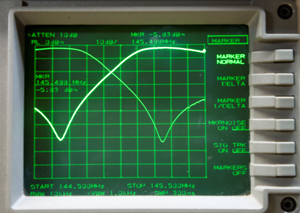History
January 21, 2014
Since we didn't announce this earlier, we'll do so now: NARCC flagged our repeater on 7.5.2013 as fully COORDINATED.
June 17, 2013
In about 3 weeks following the completion of the 60 day public review period, our repeater will be officially coordinated with NARCC.
June 14, 2012
AC6P/NR now on 145.310 MHz. Last night Prof. Steve Petersen AC6P retuned the repeater from 145.25 MHz to 145.31 MHz keeping the same -600 kHz offset. The power remains 35 watts.
January 18, 2012
AC6P/NR upgrade! This afternoon, Prof. Steve Petersen AC6P and Kerry Veenstra K3RRY raised the antenna of the UCSC repeater onto a new 21-foot mast. They also moved the antenna away from a nearby vertical metal ventilation shaft. The overall result is about an additional 16 feet in antenna height. Anyone who has been using AC6P/NR since its installation on June 8, 2011, may notice improved coverage. Steve and Kerry thank Baskin Engineering Lab Support and Baskin School of Engineering Facilities for their assistance with this endeavor.
June 8, 2011
AC6P/NR is on the air! Steve, Bob, and Kerry installed the repeater rack in the roof mechanical room of the Baskin Engineering building. The antenna cable goes through one of the room's existing roof penetrations to the Diamond F-22A antenna, which is placed on a temporary roof mount. The original plan had been to mount the antenna on an existing aluminum mast, but that mast has seized to its steel wall mount and cannot be lowered. Plans are to move the antenna to a permanent mount during the summer.
Cap (KE6AFE) is helping the team evaluate the repeater's performance.

February-April, 2011
After Steve and Kerry looked into the feasibility of constructing a 2-m duplexer, they decided that the materials cost was equal to the cost of a used, fully assembled duplexer, and so Steve acquired and tuned a Wacom WP-639. In addition, Steve vastly improved the MaxTrac transmitter's heat sink by replacing it with larger heat sink 26-80475U01 from Motorola. Then, after accepting a donation of a 19-inch rack, Steve and Bob checked out the installation site in the roof mechanical room of the Baskin Engineering building.
At this point, we are ready just to plug things together with a few hacked-together breadboard interface circuits. Instead, however, Steve created a design for an interface board, incorporating feedback from the others involved. This approach is resulting in a greater level of technical review.

August 25, 2010
The controller is programmed using touch tones. These can be received over the air from an HT, or they can be generated using a dedicated keypad at the station. Although nearly everyone has an HT, not all HTs can generate the 16 touch tones that the controller uses. So for convenience, the repeater will have a dedicated keypad. In addition, using the dedicated keypad reduces the number of times that the controller's password needs to be sent over the air.
Here are two options for a dedicated hex keypad. The first is to use a surplus TA-955 tone-dial adapter for a TA-312 field telephone. Such an adapter generates all 16 standard touch tones. Kerry has one of these keypads and merely needs to identify the output pins and determine the signal level. An amplifier can be added if the level is too low.
The second option is to use a 4x4 matrix keypad that is connected to a touch-tone generator chip. Kerry has parts for this option and will look at it if the TA-955 doesn't work out.

August 12, 2010
Kerry has assembled the repeater's controller board. Next he will make a hex keypad.
August 7, 2010
Kerry received the NHRC-2 partial kit for the station's repeater controller and has ordered the remaining parts. Cap transferred the Wacom WP-641 Duplexer to Steve, and he sold one of his Diamond F-22A antennas to the club.
August 3, 2010
Equipment
Steve is modifying a pair of Motorola Maxtrac mobile radios to work at the repeater site. Kerry has ordered an NHRC-2 Repeater Controller partial kit. He will organize parts acquisition and will construct the kit. Cap is lending a Wacom WP-641 duplexer to the effort. Steve and Kerry promise to work on a permanent duplexer solution after the station is running. Cap has a new-in-the-box Diamond F-22A 2-meter antenna that he is willing to sell.
Site Selection
Bob is key in helping determine the location of the repeater's antenna and equipment room. Kerry and Cap have found two sources of propagation-modeling software (SPLAT! 1.3.0 for Windows and CRC-COVWEB). Along with Steve, a Professional Engineer who has done propagation studies, the team is discussing site candidates now.
Schedule
The goal is to get equipment on the air by Fall 2010.
Additional References
Tuning instructions for the Wacom WP-641 duplexer
